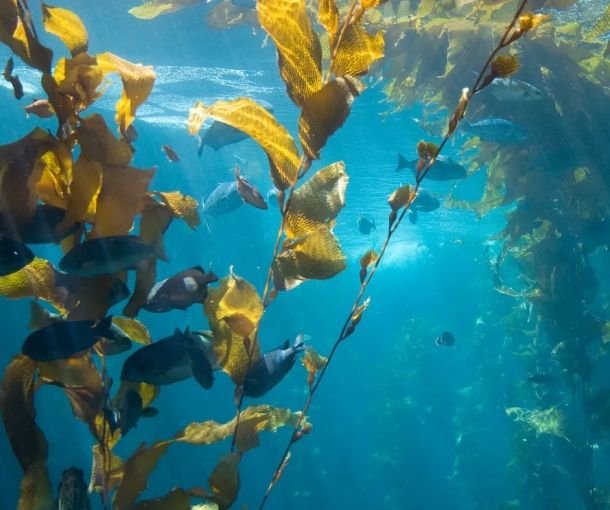Seaweed Macroalgae: A Green Ally in the Battle Against Climate Change

Introduction
The world is at a critical juncture, grappling with the multifaceted challenges posed by climate change. Rising global temperatures, intensifying weather events, and ecological disruptions underscore the urgency of addressing this global crisis. Fortunately, within the complex web of environmental solutions, there lies a remarkable, yet often overlooked, ally – seaweed macroalgae. These marine wonders possess remarkable qualities that make them uniquely suited to contribute significantly to the mitigation of climate change. In this comprehensive blog article, we will embark on a deep dive into the expansive potential of industrializing seaweed macroalgae as a pivotal force in the fight against climate change.
As greenhouse gas emissions continue to soar, atmospheric carbon dioxide (CO2) levels have reached alarming concentrations. The consequences are profound, manifesting in the form of global warming and a cascade of related ecological and environmental disruptions. In this turbulent era, the role of natural carbon sinks becomes paramount. These are nature’s mechanisms for removing CO2 from the atmosphere and locking it away, rendering it harmless. One of the most efficient carbon-sequestering organisms on Earth is seaweed macroalgae.
Seaweed macroalgae possess a remarkable capacity for photosynthesis, a process that enables them to absorb substantial quantities of CO2 from the surrounding environment. Through the magic of photosynthesis, seaweed converts this CO2 into biomass, thereby acting as a natural carbon sink. The potential to harness this innate ability for climate mitigation is a tantalizing prospect.
However, seaweed’s climate change-fighting prowess extends far beyond carbon sequestration. It encompasses a diverse array of strategies and applications, each with its unique impact on the battle against climate change. From bioenergy production and the alleviation of ocean acidification to sustainable aquaculture practices and the development of renewable biomaterials, seaweed macroalgae offers a comprehensive suite of solutions. These solutions hold the potential to revolutionize not only the way we mitigate climate change but also how we conduct industry, agriculture, and commerce in an era when sustainability is imperative.
Yet, as with any innovative solution, there are challenges to overcome. Seaweed’s industrialization necessitates scalable cultivation, robust infrastructure, and rigorous regulatory frameworks. It also demands a shift in consumer perceptions and behavior. In this article, we will explore these challenges and present innovative solutions, drawing on recent research and developments from around the world.
In essence, this comprehensive exploration of seaweed macroalgae’s role in climate change mitigation aims to shed light on its potential as a sustainable, scalable, and impactful ally in our quest to address one of the most pressing challenges of our time. As we delve into the various facets of this extraordinary natural resource, we will uncover a world of possibilities that promises to reshape industries, protect ecosystems, and chart a course toward a more sustainable future.
Seaweed as a Carbon Sink
Seaweed, through the process of photosynthesis, absorbs carbon dioxide (CO2) from the atmosphere. In fact, macroalgae are among the most efficient carbon-sequestering organisms on the planet. They convert CO2 into biomass, locking it away from the atmosphere. This inherent ability positions seaweed as a powerful natural carbon sink.
Bioenergy Production
Seaweed can be converted into biofuels, such as bioethanol and biodiesel. By utilizing these biofuels as alternatives to fossil fuels, we can significantly reduce greenhouse gas emissions. Furthermore, the cultivation of seaweed for bioenergy can create economic opportunities, particularly in coastal regions.
Alleviating Ocean Acidification
Excessive CO2 in the atmosphere not only contributes to climate change but also leads to ocean acidification. Seaweed, by absorbing CO2, helps mitigate this acidification, which is detrimental to marine ecosystems. Preserving the health of our oceans is integral to a holistic approach to climate change mitigation.
Sustainable Aquaculture Practices
Seaweed cultivation can be integrated into aquaculture systems, such as Integrated Multi-Trophic Aquaculture (IMTA). IMTA combines the cultivation of fish, shellfish, and seaweed. This integrated approach minimizes waste and nutrient runoff while enhancing ecosystem resilience.
Renewable Biomaterials for Industry
Seaweed-based biomaterials, including bioplastics, textiles, and packaging, offer sustainable alternatives to their petroleum-based counterparts. By reducing the carbon footprint of these industries, seaweed helps mitigate the emissions responsible for global warming.
Challenges and Solutions
Scale and Infrastructure
Challenge: Large-scale seaweed cultivation and processing infrastructure are needed for meaningful impact.
Solution: Collaboration between governments, research institutions, and industry can drive investments in infrastructure and scaling efforts.
Regulatory Frameworks
Challenge: Establishing clear regulations and standards for seaweed-related practices is crucial for responsible development.
Solution: Multilateral cooperation can help create international frameworks that promote sustainable seaweed practices.
Consumer Acceptance
Challenge: Convincing consumers to adopt seaweed-based products may require overcoming skepticism and educating the public.
Solution: Effective marketing and education campaigns, as well as certifications, can build trust and drive adoption.
Conclusion
Seaweed macroalgae, often underappreciated, possesses immense potential to mitigate climate change. Through carbon sequestration, bioenergy production, ocean acidification mitigation, sustainable aquaculture practices, and the development of renewable biomaterials, seaweed can significantly contribute to a more sustainable future.
By addressing challenges related to scale, regulation, and consumer acceptance, we can harness the full potential of seaweed in the fight against climate change. It’s time to recognize seaweed as a green ally and invest in its industrialized use to combat one of the most pressing challenges of our time.
References:
Hurd, C. L., Lenton, A., Tilbrook, B., Boyd, P. W., & Matear, R. J. (2018). Advances in understanding the potential impacts of ocean acidification on oceanic calcareous algae. Marine and Freshwater Research, 69(4), 361-372.
Mata, T. M., Martins, A. A., & Caetano, N. S. (2010). Microalgae for biodiesel production and other applications: a review. Renewable and Sustainable Energy Reviews, 14(1), 217-232.
Perez-Garcia, O., Escalante, F. M. E., de-Bashan, L. E., & Bashan, Y. (2011). Heterotrophic cultures of microalgae: metabolism and potential products. Water Research, 45(1), 11-36.
Wijffels, R. H., & Barbosa, M. J. (2010). An outlook on microalgal biofuels. Science, 329(5993), 796-799.


